
Nepenthes tentaculata, or the fringed pitcher-plant, is a tropical pitcher plant with a wide distribution across Borneo and Sulawesi. It grows at altitudes of 400–2550 m.

Nepenthes hirsuta, the hairy pitcher-plant, is a tropical pitcher plant endemic to Borneo. It is characterised by an indumentum of thick brown hairs, which is even present on the inflorescence. Pitchers are mostly green throughout with some having red blotches on the inside surfaces.
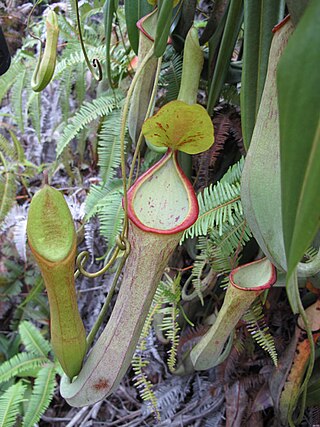
Nepenthes macrovulgaris, or the serpentine pitcher-plant, is a tropical pitcher plant endemic to Borneo. It is a lowland plant that typically grows at altitudes ranging from 300 to 1200 m in sub-montane forest clearings and mossy forest. Its range is restricted to ultramafic habitats, including Mount Kinabalu, Mount Tambuyukon, the Danum Valley, the Tawai Range, the Meliau Range and Mount Silam, all in Sabah, Malaysian Borneo. Pitchers grow to around 25 cm high and range in colour from green to brown, with the speckled form being the most common.

Nepenthes hamata is a tropical pitcher plant endemic to Sulawesi, where it grows at elevations of 1400–2500 m above sea level.

Nepenthes maxima, the great pitcher-plant, is a carnivorous pitcher plant species of the genus Nepenthes. It has a relatively wide distribution covering New Guinea, Sulawesi, and the Maluku Islands. It may also be present on Wowoni Island.
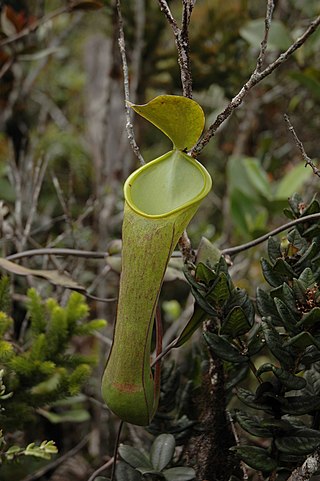
Nepenthes murudensis, or the Murud pitcher-plant, is a tropical pitcher plant endemic to Mount Murud in Borneo, after which it is named. It is of putative hybrid origin: its two original parent species are thought to be N. reinwardtiana and N. tentaculata.
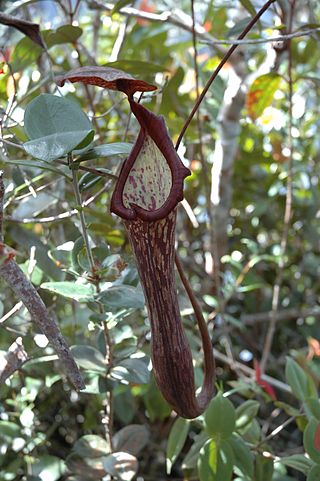
Nepenthes faizaliana is a tropical pitcher plant endemic to the limestone cliffs of Gunung Mulu National Park in Sarawak, Borneo. It is thought to be most closely related to N. boschiana.
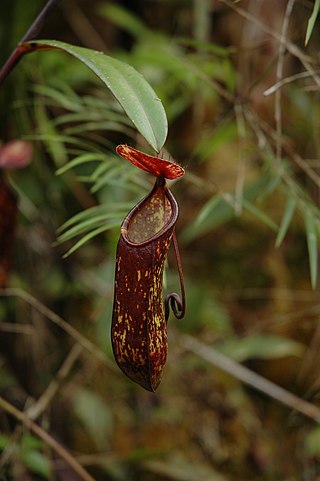
Nepenthes muluensis, or the Mulu pitcher-plant, is a tropical pitcher plant endemic to Borneo. It grows in highland habitats at elevations of 1700 to 2400 m above sea level.

Nepenthes adnata is a tropical pitcher plant endemic to the Indonesian province of West Sumatra, where it grows at elevations of 600 to 1200 m above sea level. The specific epithet adnata is Latin for "broadly attached" and refers to the base of the lamina.
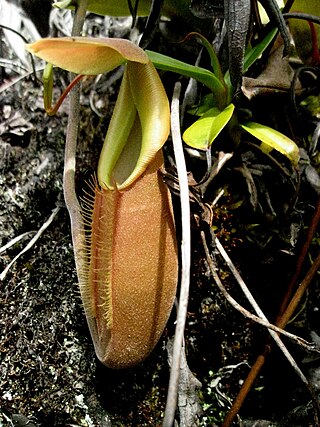
Nepenthes bongso is a tropical pitcher plant endemic to Sumatra, where it has an altitudinal distribution of 1000–2700 m above sea level. The specific epithet bongso refers to the Indonesian legend of Putri Bungsu, the spirit guardian of Mount Marapi.
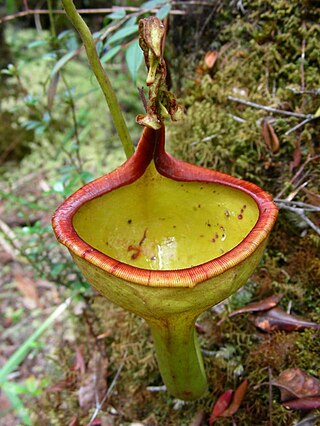
Nepenthes eymae is a tropical pitcher plant endemic to Sulawesi in Indonesia, where it grows at elevations of 1,000–2,000 m (3,300–6,600 ft) above sea level. It is very closely related to N. maxima, from which it differs in its wine glass-shaped upper pitchers.

Nepenthes lamii is a tropical pitcher plant endemic to New Guinea, where it grows at an altitude of up to 3520 m above sea level, higher than any other Nepenthes species. Although once confused with N. vieillardii and previously regarded as conspecific with the closely related N. monticola, it is now recognised as a distinct species.
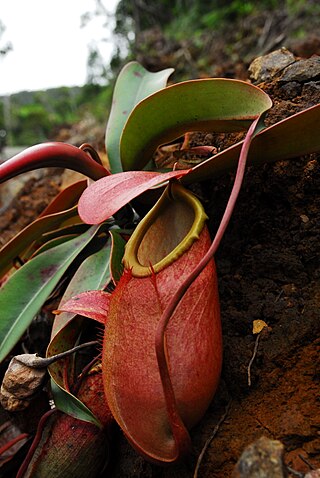
Nepenthes merrilliana is a tropical pitcher plant endemic to the Philippines. It produces some of the largest pitchers in the genus, rivalling those of N. rajah.
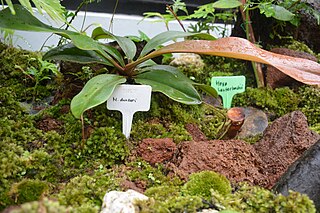
Nepenthes danseri is a species of tropical pitcher plant. It is known only from the northern coast of Waigeo Island; plants from Halmahera, the largest of the Maluku Islands, are now recognised as belonging to a separate species, N. halmahera.
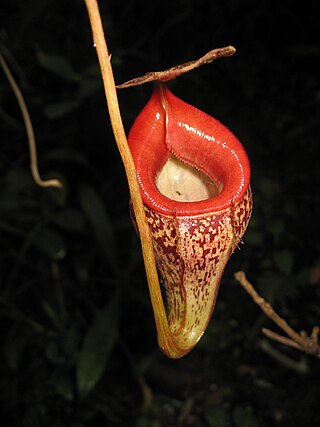
Nepenthes talangensis is a tropical pitcher plant endemic to Sumatra, where it grows in upper montane forest at elevations of 1800–2500 m above sea level.
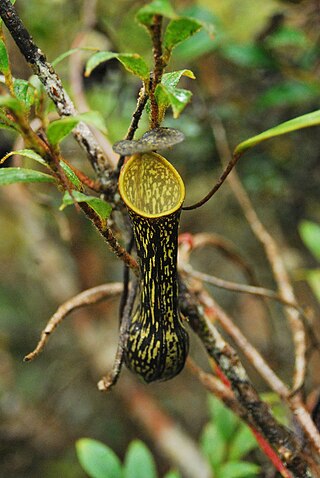
Nepenthes mikei is a tropical pitcher plant endemic to Sumatra. It is characterised by its black mottled lower and upper pitchers. The species is closely related to N. angasanensis and N. tobaica.

Nepenthes thorelii is a tropical pitcher plant endemic to Indochina. Very little is known about N. thorelii and it is unlikely to have entered cultivation, although various other taxa are often mislabelled as this species in the plant trade. Prior to its rediscovery in 2011, N. thorelii was considered possibly extinct, both in the wild and in cultivation.

Nepenthes tomoriana is a species of pitcher plant endemic to Sulawesi, where it grows at an elevation of 0–500 m above sea level.

Nepenthes rhombicaulis is a tropical pitcher plant endemic to Sumatra. The specific epithet rhombicaulis is formed from the Latin words rhombicus, meaning "rhomboid", and caulis, "stem". It refers to the cross-sectional shape of the stem internodes.
Nepenthes maryae is a tropical pitcher plant native to Central Sulawesi province on the Indonesian island of Sulawesi. It is known from a single herbarium specimen collected in 2000 on an undisclosed mountain at 2100 m above sea level, where the species grew in submontane mossy forest alongside N. eymae, N. nigra, and N. tentaculata. It is a member of section Tentaculatae, which also includes 8 other species from Borneo and Sulawesi: N. glabrata, N. hamata, N. muluensis, N. murudensis, N. nigra, N. pitopangii, N. tentaculata, and N. undulatifolia. Nepenthes maryae is distinguished from all other species in this group by the presence of short hairs on the lower surface of the pitcher lid and bracts on the majority of flowers.

























